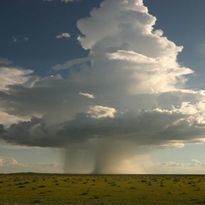In Mosa Mack’s Weather unit, students are led through a progression of three inquiry lessons that focus on temperature, pressure, and the corresponding weather patterns.
- Lesson 1
Solve: Wedding Weather Mystery + Vocabulary Mind Map
Students will contextualize weather vocabulary before helping Mosa Mack solve the mystery of why storms seem to have such different characteristics in different regions. (75 minutes)
- Lesson 2
Make: Model Weather Fronts
Students plan and act out a model of the various factors that contribute to a weather front of their choice. (150 minutes)
- Lesson 3
Engineer: Become a Meteorologist
Students apply their knowledge of weather and act as meteorologists to design a weather report that predicts and explains a day of weather in a region of their choice. (150 minutes)
- Next Generation Science Standards
- MS-ESS2-5
- Collect data to provide evidence for how the motions and complex interactions of air masses result in changes in weather conditions. [Clarification Statement: Emphasis is on how air masses flow from regions of high pressure to low pressure, causing weather (defined by temperature, pressure, humidity, precipitation, and wind) at a fixed location to change over time, and how sudden changes in weather can result when different air masses collide. Emphasis is on how weather can be predicted within probabilistic ranges. Examples of data can be provided to students (such as weather maps, diagrams, and visualizations) or obtained through laboratory experiments (such as with condensation).] [Assessment Boundary: Assessment does not include recalling the names of cloud types or weather symbols used on weather maps or the reported diagrams from weather stations.]
- Inquiry Scale
- Each lesson in the unit has an Inquiry Scale that provides directions on how to implement the lesson at the level that works best for you and your students.
- “Level 1” is the most teacher-driven, and recommended for students in 4th-5th grades. “Level 4” is the most student-driven, and recommended for students in 7th-8th grades.
- For differentiation within the same grade or class, use different inquiry levels for different groups of students who may require additional support or an extra challenge.
- Common Misconceptions
- Students often think that the reason some areas of the Earth are warmer than others is due to its distance from the Sun. Emphasize to students using diagrams and models that the Earth’s tilt, and the angles at which the Sun hits the Earth is the reason why some areas on the Earth are warmer than others.
- Students often associate storms exclusively with cold weather, but there are a variety of other factors at play, including humidity and air masses. Use the comic as well as the informational review in “The Make” to emphasize these other factors to students.
- Vocabulary
- Temperature
- Weather Front
- Humidity
- Air Mass
- Precipitation
- Wind Speed
- Sun Angle
- Content Expert
- Simon Brewer
Storm Chaser & Meteorologist
- Leveled Reading
* To give our users the most comprehensive science resource, Mosa Mack is piloting a partnership with RocketLit, a provider of leveled science articles.
- Climate vs Weather in the Arctic
This article uses at the Arctic as an example of the difference between Climate and Weather. We also define Temperature and Climate Change, specifically talking about the data over time that's needed to show the Climate is changing. Even though temperatures change over the course of a year, that doesn't mean the climate is changing.
RocketLit serves tailored Science reading to every student in your classroom at their independent reading level.
- Water Doesn't Just Fall From the Sky
To read this sentence, you need to look through water that's floating in the air as humidity. This article explains that you won't be able to see this water until the dew point is reached or as this water gathers in the sky as clouds.
RocketLit serves tailored Science reading to every student in your classroom at their independent reading level.
- Rain or Shine?
In this article, students learn about the basics of weather and the patterns that we see. Weather is the way the atmosphere looks at one moment, but climate is how we describe what the weather is generally like all the time. Students also learn about seasons in different parts of the world.
RocketLit serves tailored Science reading to every student in your classroom at their independent reading level.
- The Air Around You is REALLY Pushy
Right now, the air is pushing down on you. In the sky, how much the air is pushing will change what the weather looks like. This article explains the ideas behind low pressure, and high pressure and a front.
RocketLit serves tailored Science reading to every student in your classroom at their independent reading level.
- How to Mess Up Your Hair
The only thing students might know about wind is that it really messes up their hair. This article talks about how uneven heating, convection, and the Coriolis effect work together to produce wind.
RocketLit serves tailored Science reading to every student in your classroom at their independent reading level.
- Your Very Own Pet Water Drop
In this article, students read about the basic steps in the water cycle. The article discusses what causes most of the evaporation, how water drops gather together in the sky and why they fall back down to earth.
RocketLit serves tailored Science reading to every student in your classroom at their independent reading level.
- The Hydrologic Cycle
This article is a more rigorous and thorough version of the "Your Own Pet Water Drop" article to introduce students to the Water (Hydrological) Cycle. This article details all the steps of the Water (Hydrological) Cycle and goes into additional detail to explain water reservoirs and groundwater.
RocketLit serves tailored Science reading to every student in your classroom at their independent reading level.



